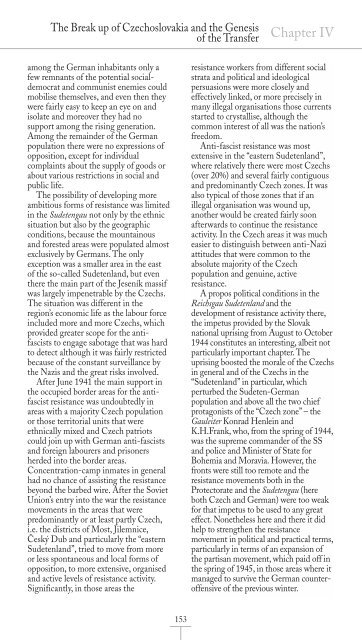the nationality of all inhabitants of the czech provinces and ...
the nationality of all inhabitants of the czech provinces and ...
the nationality of all inhabitants of the czech provinces and ...
You also want an ePaper? Increase the reach of your titles
YUMPU automatically turns print PDFs into web optimized ePapers that Google loves.
The Break up <strong>of</strong> Czechoslovakia <strong>and</strong> <strong>the</strong> Genesis<br />
<strong>of</strong> <strong>the</strong> Transfer<br />
among <strong>the</strong> German <strong>inhabitants</strong> only a<br />
few remnants <strong>of</strong> <strong>the</strong> potential socialdemocrat<br />
<strong>and</strong> communist enemies could<br />
mobilise <strong>the</strong>mselves, <strong>and</strong> even <strong>the</strong>n <strong>the</strong>y<br />
were fairly easy to keep an eye on <strong>and</strong><br />
isolate <strong>and</strong> moreover <strong>the</strong>y had no<br />
support among <strong>the</strong> rising generation.<br />
Among <strong>the</strong> remainder <strong>of</strong> <strong>the</strong> German<br />
population <strong>the</strong>re were no expressions <strong>of</strong><br />
opposition, except for individual<br />
complaints about <strong>the</strong> supply <strong>of</strong> goods or<br />
about various restrictions in social <strong>and</strong><br />
public life.<br />
The possibility <strong>of</strong> developing more<br />
ambitious forms <strong>of</strong> resistance was limited<br />
in <strong>the</strong> Sudetengau not only by <strong>the</strong> ethnic<br />
situation but also by <strong>the</strong> geographic<br />
conditions, because <strong>the</strong> mountainous<br />
<strong>and</strong> forested areas were populated almost<br />
exclusively by Germans. The only<br />
exception was a sm<strong>all</strong>er area in <strong>the</strong> east<br />
<strong>of</strong> <strong>the</strong> so-c<strong>all</strong>ed Sudetenl<strong>and</strong>, but even<br />
<strong>the</strong>re <strong>the</strong> main part <strong>of</strong> <strong>the</strong> Jeseník massif<br />
was largely impenetrable by <strong>the</strong> Czechs.<br />
The situation was different in <strong>the</strong><br />
region’s economic life as <strong>the</strong> labour force<br />
included more <strong>and</strong> more Czechs, which<br />
provided greater scope for <strong>the</strong> antifascists<br />
to engage sabotage that was hard<br />
to detect although it was fairly restricted<br />
because <strong>of</strong> <strong>the</strong> constant surveillance by<br />
<strong>the</strong> Nazis <strong>and</strong> <strong>the</strong> great risks involved.<br />
After June 1941 <strong>the</strong> main support in<br />
<strong>the</strong> occupied border areas for <strong>the</strong> antifascist<br />
resistance was undoubtedly in<br />
areas with a majority Czech population<br />
or those territorial units that were<br />
ethnic<strong>all</strong>y mixed <strong>and</strong> Czech patriots<br />
could join up with German anti-fascists<br />
<strong>and</strong> foreign labourers <strong>and</strong> prisoners<br />
herded into <strong>the</strong> border areas.<br />
Concentration-camp inmates in general<br />
had no chance <strong>of</strong> assisting <strong>the</strong> resistance<br />
beyond <strong>the</strong> barbed wire. After <strong>the</strong> Soviet<br />
Union’s entry into <strong>the</strong> war <strong>the</strong> resistance<br />
movements in <strong>the</strong> areas that were<br />
predominantly or at least partly Czech,<br />
i.e. <strong>the</strong> districts <strong>of</strong> Most, Jilemnice,<br />
Český Dub <strong>and</strong> particularly <strong>the</strong> “eastern<br />
Sudetenl<strong>and</strong>”, tried to move from more<br />
or less spontaneous <strong>and</strong> local forms <strong>of</strong><br />
opposition, to more extensive, organised<br />
<strong>and</strong> active levels <strong>of</strong> resistance activity.<br />
Significantly, in those areas <strong>the</strong><br />
153<br />
Chapter IV<br />
resistance workers from different social<br />
strata <strong>and</strong> political <strong>and</strong> ideological<br />
persuasions were more closely <strong>and</strong><br />
effectively linked, or more precisely in<br />
many illegal organisations those currents<br />
started to cryst<strong>all</strong>ise, although <strong>the</strong><br />
common interest <strong>of</strong> <strong>all</strong> was <strong>the</strong> nation’s<br />
freedom.<br />
Anti-fascist resistance was most<br />
extensive in <strong>the</strong> “eastern Sudetenl<strong>and</strong>”,<br />
where relatively <strong>the</strong>re were most Czechs<br />
(over 20%) <strong>and</strong> several fairly contiguous<br />
<strong>and</strong> predominantly Czech zones. It was<br />
also typical <strong>of</strong> those zones that if an<br />
illegal organisation was wound up,<br />
ano<strong>the</strong>r would be created fairly soon<br />
afterwards to continue <strong>the</strong> resistance<br />
activity. In <strong>the</strong> Czech areas it was much<br />
easier to distinguish between anti-Nazi<br />
attitudes that were common to <strong>the</strong><br />
absolute majority <strong>of</strong> <strong>the</strong> Czech<br />
population <strong>and</strong> genuine, active<br />
resistance.<br />
A propos political conditions in <strong>the</strong><br />
Reichsgau Sudetenl<strong>and</strong> <strong>and</strong> <strong>the</strong><br />
development <strong>of</strong> resistance activity <strong>the</strong>re,<br />
<strong>the</strong> impetus provided by <strong>the</strong> Slovak<br />
national uprising from August to October<br />
1944 constitutes an interesting, albeit not<br />
particularly important chapter. The<br />
uprising boosted <strong>the</strong> morale <strong>of</strong> <strong>the</strong> Czechs<br />
in general <strong>and</strong> <strong>of</strong> <strong>the</strong> Czechs in <strong>the</strong><br />
“Sudetenl<strong>and</strong>” in particular, which<br />
perturbed <strong>the</strong> Sudeten-German<br />
population <strong>and</strong> above <strong>all</strong> <strong>the</strong> two chief<br />
protagonists <strong>of</strong> <strong>the</strong> “Czech zone” – <strong>the</strong><br />
Gauleiter Konrad Henlein <strong>and</strong><br />
K.H.Frank, who, from <strong>the</strong> spring <strong>of</strong> 1944,<br />
was <strong>the</strong> supreme comm<strong>and</strong>er <strong>of</strong> <strong>the</strong> SS<br />
<strong>and</strong> police <strong>and</strong> Minister <strong>of</strong> State for<br />
Bohemia <strong>and</strong> Moravia. However, <strong>the</strong><br />
fronts were still too remote <strong>and</strong> <strong>the</strong><br />
resistance movements both in <strong>the</strong><br />
Protectorate <strong>and</strong> <strong>the</strong> Sudetengau (here<br />
both Czech <strong>and</strong> German) were too weak<br />
for that impetus to be used to any great<br />
effect. None<strong>the</strong>less here <strong>and</strong> <strong>the</strong>re it did<br />
help to streng<strong>the</strong>n <strong>the</strong> resistance<br />
movement in political <strong>and</strong> practical terms,<br />
particularly in terms <strong>of</strong> an expansion <strong>of</strong><br />
<strong>the</strong> partisan movement, which paid <strong>of</strong>f in<br />
<strong>the</strong> spring <strong>of</strong> 1945, in those areas where it<br />
managed to survive <strong>the</strong> German counter<strong>of</strong>fensive<br />
<strong>of</strong> <strong>the</strong> previous winter.


